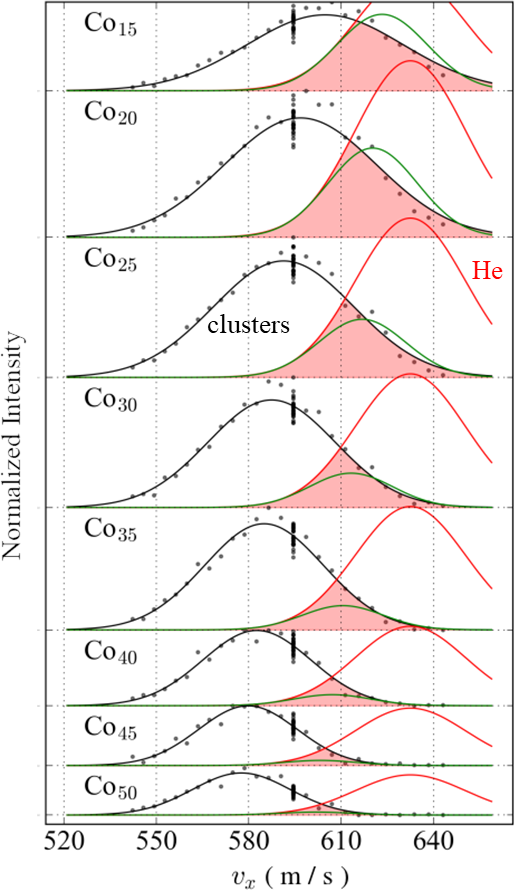Size-dependent velocity distributions and temperatures of metal clusters in a helium carrier gas
[Bibtex]
@article{
author = {Johan van der Tol and Ewald Janssens},
title = {Size-dependent velocity distributions and
temperatures of metal clusters in a helium carrier gas},
journal = {Physical Review A},
volume = {102},
number = {022806},
abstract = {Combining a laser vaporization cluster source, a velocity scan system, and a time-of-flight mass spectrometer, we measured velocity distributions of few-atom cobalt clusters ( Co n , n = 6 – 60 ) suspended in a helium carrier gas and expanded into vacuum. The velocity distributions provide information about the cluster size dependence of the translational temperature, flow velocity, and velocity slip with respect to the helium carrier gas. The system of clusters in a carrier gas is found to violate the equipartition theorem. Although the clusters in the expansion do not thermalize with the helium gas, they do experience significant, size-dependent internal cooling. While expanding into vacuum, the clusters collide, at least a couple of hundred times, superelastically with the carrier gas, thereby transferring internal vibrational energy into self-acceleration and increasing the flow velocity of the gas as a whole. It is also demonstrated that the proposed velocity distribution measurements can be used to test whether a source produces thermalized clusters.},
year = {2020},
type= {Article},
}- DOI number: 10.1103/PhysRevA.102.022806
- Corresponding author contact e-mails: ewald.janssens@kuleuven.be

While the thermodynamics of small molecules and atoms in a carrier gas is for a long time quite well understood, this is not the case for much heavier clusters of atoms. The earlier knowledge cannot simply be applied to atomic clusters because of large velocity slips and the large heat capacity of the clusters.
We have developed an approach to measure the velocity distributions of metal clusters suspended in a helium carrier gas and expanded into vacuum. Those velocity distributions provide information about the cluster size dependence of the translational temperature, flow velocity, and velocity slip with respect to the helium carrier gas.
The system of clusters in a carrier gas is found to violate the equipartition theorem. Although the clusters in the expansion do not thermalize with the helium gas, they do experience significant, size-dependent internal cooling. While expanding into vacuum, the clusters collide, at least a couple of hundred times, superelastically with the carrier gas, thereby transferring internal vibrational energy into self-acceleration and increasing the flow velocity of the gas as a whole. We demonstrated that the proposed velocity distribution measurements can be used to test whether a source produces thermalized clusters.